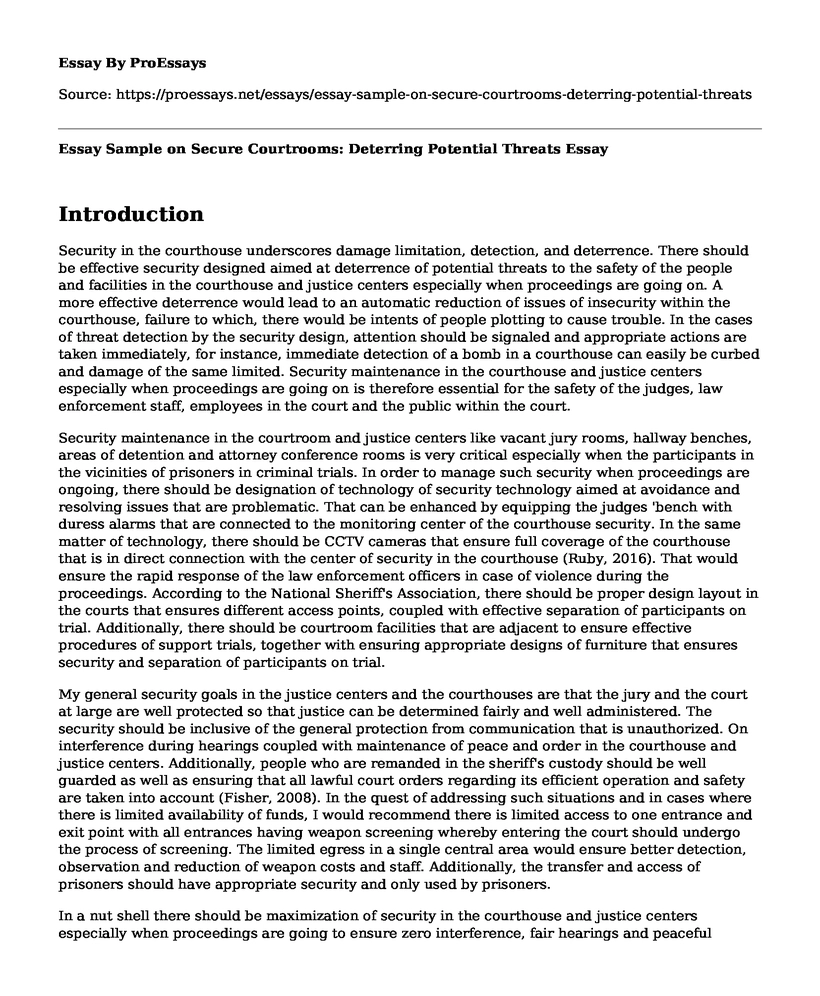Introduction
Security in the courthouse underscores damage limitation, detection, and deterrence. There should be effective security designed aimed at deterrence of potential threats to the safety of the people and facilities in the courthouse and justice centers especially when proceedings are going on. A more effective deterrence would lead to an automatic reduction of issues of insecurity within the courthouse, failure to which, there would be intents of people plotting to cause trouble. In the cases of threat detection by the security design, attention should be signaled and appropriate actions are taken immediately, for instance, immediate detection of a bomb in a courthouse can easily be curbed and damage of the same limited. Security maintenance in the courthouse and justice centers especially when proceedings are going on is therefore essential for the safety of the judges, law enforcement staff, employees in the court and the public within the court.
Security maintenance in the courtroom and justice centers like vacant jury rooms, hallway benches, areas of detention and attorney conference rooms is very critical especially when the participants in the vicinities of prisoners in criminal trials. In order to manage such security when proceedings are ongoing, there should be designation of technology of security technology aimed at avoidance and resolving issues that are problematic. That can be enhanced by equipping the judges 'bench with duress alarms that are connected to the monitoring center of the courthouse security. In the same matter of technology, there should be CCTV cameras that ensure full coverage of the courthouse that is in direct connection with the center of security in the courthouse (Ruby, 2016). That would ensure the rapid response of the law enforcement officers in case of violence during the proceedings. According to the National Sheriff's Association, there should be proper design layout in the courts that ensures different access points, coupled with effective separation of participants on trial. Additionally, there should be courtroom facilities that are adjacent to ensure effective procedures of support trials, together with ensuring appropriate designs of furniture that ensures security and separation of participants on trial.
My general security goals in the justice centers and the courthouses are that the jury and the court at large are well protected so that justice can be determined fairly and well administered. The security should be inclusive of the general protection from communication that is unauthorized. On interference during hearings coupled with maintenance of peace and order in the courthouse and justice centers. Additionally, people who are remanded in the sheriff's custody should be well guarded as well as ensuring that all lawful court orders regarding its efficient operation and safety are taken into account (Fisher, 2008). In the quest of addressing such situations and in cases where there is limited availability of funds, I would recommend there is limited access to one entrance and exit point with all entrances having weapon screening whereby entering the court should undergo the process of screening. The limited egress in a single central area would ensure better detection, observation and reduction of weapon costs and staff. Additionally, the transfer and access of prisoners should have appropriate security and only used by prisoners.
In a nut shell there should be maximization of security in the courthouse and justice centers especially when proceedings are going to ensure zero interference, fair hearings and peaceful administration of justice. Even with limited availability of funds, security in the courthouse should be the topmost priority stemming from the employees wearing identification cards that is visible to substantiate legitimate workers from visitors and others. The IDs would also be used as key cards to access authorized offices coupled with electronic key cards that would provide records of every employees' movements in the building and allow their access to certain areas only.
References
Fisher, K., S. (2008, March).Implementing a Risk-Based Approach to Court Security. Naval PostGraduate School. Monterey, California. Retrieved fromhttps://apps.dtic.mil/dtic/tr/fulltext/u2/a479932.pdf
National Sheriff's Association. (1978).Court Security-A Manual of Guidelines and Procedures.National Criminal Justice Reference Service. Retrieved fromhttps://www.ncjrs.gov/App/Publications/abstract.aspx?ID=47854
Ruby. A. (2016, July).Safety First: 5 Critical Courtroom Security Procedures. Fentress Blog.Retrieved from https://blog.fentress.com/blog/critical-courtroom-securityprocedures
Cite this page
Essay Sample on Secure Courtrooms: Deterring Potential Threats. (2023, Mar 27). Retrieved from https://proessays.net/essays/essay-sample-on-secure-courtrooms-deterring-potential-threats
If you are the original author of this essay and no longer wish to have it published on the ProEssays website, please click below to request its removal:
- Is Organized Crime Evolving into a Conventional Business Model Style of Operations?
- Medical and Insurance Options Essay
- Gay Right Movements in the US Essay Example
- Essay Sample on Criminal Defense
- Expository Essay on Legal Issues Facing Nurses
- Essay Sample on Harriet Tubman's Fight for Civil Rights: A Historical Perspective
- Paper on Separation of Employees and Supervisory Issues in Seattle v. Amalgamated Transit Union (1977)







